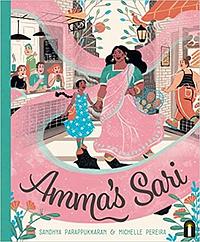Take a photo of a barcode or cover
lighthearted
reflective
fast-paced
Plot or Character Driven:
Character
Strong character development:
No
Loveable characters:
Yes
Diverse cast of characters:
No
Flaws of characters a main focus:
Yes
Loveable characters:
Yes
Diverse cast of characters:
Yes
lighthearted
reflective
relaxing
fast-paced
Plot or Character Driven:
Character
Strong character development:
Yes
Loveable characters:
N/A
Diverse cast of characters:
Yes
Flaws of characters a main focus:
Yes
an empowering story of cultural nourishment and connection beautifully and lovingly told. I appreciate how the girl's feelings are never invalidated; they are honored and developed. I love how the flashbacks work as the mother shares her memories of growing up with women who wore saris. I like how concrete the word-images are.
Full, lavish pages flesh out this story from beginning to end. It's about a girl embracing her heritage and learning to ignore the curious and ignorant stares from strangers. It is about the beauty and belonging of the sari. The illustrations really highlight the protagonist's emotions, from gleeful, to confused, to scared. The mother (Amma) and some of the background characters look fat to me (love to see it!). "The art in this book was created digitally."
emotional
lighthearted
reflective
fast-paced
challenging
emotional
informative
inspiring
reflective
medium-paced
I love the visual use of the sari as something almost magical and that it retains that quality even as the world around it changes and tries to pass judgement or dark clouds.
The illustrations are nice, but the story is contrived and unrealistic, creating a straw man argument in order to share a moral message. The author portrays this young girl and her mother walking through the city, and everywhere they go, people are shocked by the mother's sari, stare at her in disapproval, and act disturbed by her presence. The little girl feels ashamed of her mother's sari at first, but eventually comes to accept this beautiful part of her culture.
The author portrays the tension that immigrants experience between assimilation and expressing their cultural background, but the story goes way overboard. It is not conceivably possible that everyone, everywhere, has a negative reaction to the sari. This is set in a very diverse and cosmopolitan city, but even if this was set in a rural area, people STILL would not have a universally negative reaction. I kept expecting someone to react positively or not react at all, but the negative scenarios kept piling on, and it's just not realistic.
People are likely to do double-takes at anyone who is dressed very differently from the norm, and some inconsiderate people may stare. However, even the people who stare may be curious, admiring, and interested. This book makes it explicitly clear through the descriptions and illustrations that everyone is acting judgmental and hateful, and that is so disconnected from reality that it ends up undermining the author's point.
Certainly, a few people's stares or hushed whispers will affect an immigrant child very negatively, and they may generalize this to other people, assuming that everyone is judging their family. That's really hard. But this book basically takes a harmful cognitive distortion and runs with it, actively portraying shocked faces, stares, and ugly glares in every single place this mother and child go. This book's unrealistic portrayal can harm young immigrant children by teaching them to expect an intense, universal level of judgment. There are also many better ways to encourage other kids to act welcoming, without making it sound like every single person in an entire city is judging people who wear clothes from different cultures!
The author portrays the tension that immigrants experience between assimilation and expressing their cultural background, but the story goes way overboard. It is not conceivably possible that everyone, everywhere, has a negative reaction to the sari. This is set in a very diverse and cosmopolitan city, but even if this was set in a rural area, people STILL would not have a universally negative reaction. I kept expecting someone to react positively or not react at all, but the negative scenarios kept piling on, and it's just not realistic.
People are likely to do double-takes at anyone who is dressed very differently from the norm, and some inconsiderate people may stare. However, even the people who stare may be curious, admiring, and interested. This book makes it explicitly clear through the descriptions and illustrations that everyone is acting judgmental and hateful, and that is so disconnected from reality that it ends up undermining the author's point.
Certainly, a few people's stares or hushed whispers will affect an immigrant child very negatively, and they may generalize this to other people, assuming that everyone is judging their family. That's really hard. But this book basically takes a harmful cognitive distortion and runs with it, actively portraying shocked faces, stares, and ugly glares in every single place this mother and child go. This book's unrealistic portrayal can harm young immigrant children by teaching them to expect an intense, universal level of judgment. There are also many better ways to encourage other kids to act welcoming, without making it sound like every single person in an entire city is judging people who wear clothes from different cultures!





